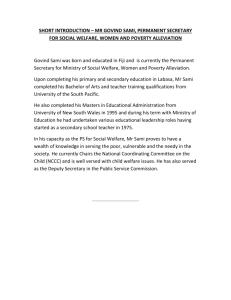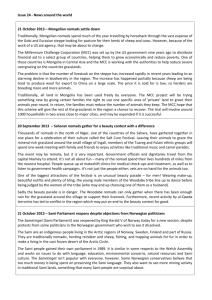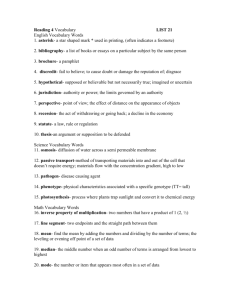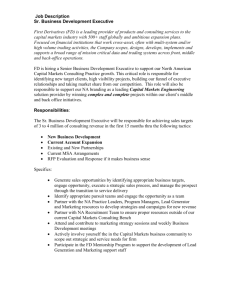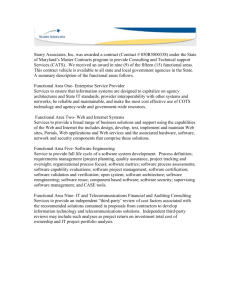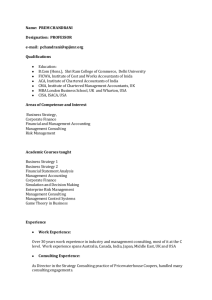here - SAMI Consulting
advertisement
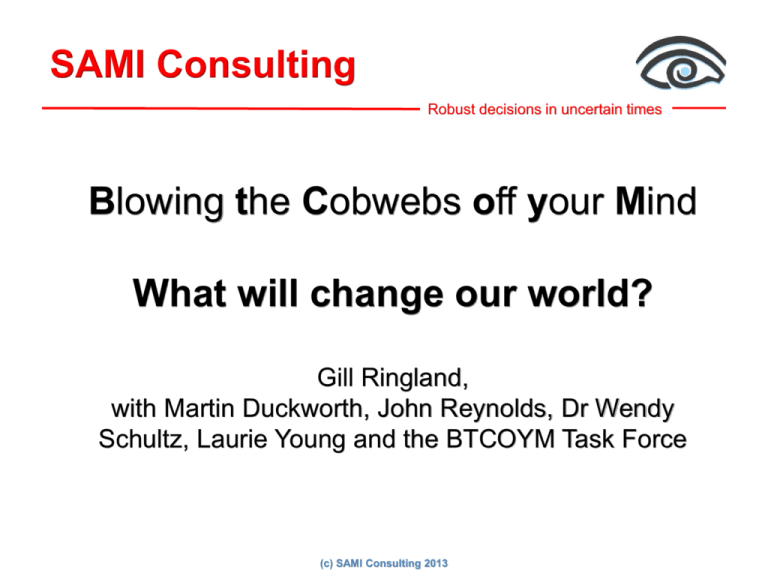
SAMI Consulting Robust decisions in uncertain times Blowing the Cobwebs off your Mind What will change our world? Gill Ringland, with Martin Duckworth, John Reynolds, Dr Wendy Schultz, Laurie Young and the BTCOYM Task Force (c) SAMI Consulting 2013 Four major forces Robust decisions in uncertain times • Demographics – societal forces • West to East – political and economic forces • Environment and resources – limits and impacts • Technology – challenges and opportunities This deck also contains some provocations: • could the world be very different from our expectations? (c) SAMI Consulting 2013 Demographics Robust decisions in uncertain times (c) SAMI Consulting 2013 Global population Robust decisions in uncertain times Source: UN Population Division (c) SAMI Consulting 2013 Where will they be? Robust decisions in uncertain times 10 Billions 8 6 Africa Rest of Asia China India Latin America Oceania Northern America Europe World Population Prospects UN Population Division: 2006 Revision 4 2 0 1950 1975 2000 Source: UN Population Division (c) SAMI Consulting 2013 2025 2050 An ageing population Robust decisions in uncertain times 800 Other less developed World 2050 Age Pyramid India 600 China More developed regions 400 200 Source: UN Population Division (c) SAMI Consulting 2013 90-94 80-84 70-74 60-64 50-54 40-44 30-34 20-24 10-14 0-4 0 Migration Robust decisions in uncertain times Migration increases due to economic factors – south to south as well as south to north Also increases due to environmental degradation: as other parts of the world become too hot or too dry, become flooded, Northern Europe could become a target for environmental refugees. Increases due to regions of constant conflict, Increases in urban conflict from new waves of migrants. Undocumented migrants pose problems for governments and NGOs. (c) SAMI Consulting 2013 Workforce – war for labour Robust decisions in uncertain times In order to maintain the economic growth rate of the two decades before the crisis, the USA needs 26 million and Europe 46 million more people by 2030. People will be encouraged to work longer, with an explosion in life-long learning, retraining for new careers and flexible hours. Even developing countries will hit the working age inflection point by 2050. Source: http://www.eurofound.europa.eu/ewco/surveyreports/EU0902019D/EU0902019D_2.htm (c) SAMI Consulting 2013 Lifestyle diseases go global Robust decisions in uncertain times Health in the developed world is under threat due to ignorance or complacency about the effect of lifestyle choices. In the US, the total number of people with diabetes is predicted to rise from 11million in 2000 to almost 20 million in 2025. By 2050, this is projected at 29 million people—a 165% increase over the 2000 level. Whilst some of this can be attributed to natural causes, much of it is down to unhealthy living In the developing world diseases once thought of as being a developed-country problem are rapidly increasing due to a globalisation of lifestyle, urbanisation and increasing affluence. Source: http://care.diabetesjournals.org/content/24/11/1936.full.pdf+html (c) SAMI Consulting 2013 Increasing role of women Robust decisions in uncertain times Education of women reduces family size and population growth – evidence from Kerala vs India average. Move to cities increases women’s education and role in paid work: increases size of formal economy. Demographic and Socioeconomic Indicators in India and the United States, 2000 US India Kerala Total fertility rate 2.1 2.9 1.7 Infant mortality rate 65 58 12 Life expectancy (male) 75 62 71 Life expectancy (female) 80 64 76 Female literacy 99 54 88 Contraceptive prevalence (all methods) 73 56 69 Will we see more involvement by women in politics? More consensus working? Source: http://www.unfpa.org/pds/poverty.html, http://www.prb.org/Educators/TeachersGuides/HumanPopulation/Women.aspx (c) SAMI Consulting 2013 West to East Robust decisions in uncertain times (c) SAMI Consulting 2013 Growth outside the G7 Robust decisions in uncertain times China and India will continue to grow faster than OECD countries. With huge populations, as GDP per person rises, their economic influence will grow. Economic power leads to political, social and ethical dominance in the following decades. GDP in US $ billions 90000 80000 70000 60000 50000 Big 5+M 40000 G7 30000 20000 By 2050 (halfway through the “Pacific Century”), the geopolitical landscape will have changed as the combined Big 5 +M (BRIC plus Indonesia and Mexico) GDP exceeds the GDP of the G7. 10000 0 Source: http://carnegieendowment.org/files/World_Order_in_2050.pdf (c) SAMI Consulting 2013 2009 2030 2050 GDP by 2050 Robust decisions in uncertain times • • • • • Crucial role of demographics in driving economics Everywhere will have an older population by 2050 Asia is not homogeneous – East Asia ageing fast, India, Indonesia, Philippines about 30% under 14 Africa starts to boom (Uganda 50% under 14) Fast growing middle class in Asia and Latin America: service economies boom in BRIC countries (c) SAMI Consulting 2013 GDP per capita by 2050 Robust decisions in uncertain times The current trend is for incomes within countries to become more unequal, but for the differences between the richest and poorest countries to become less so. Over a billion new middle class consumers in Asia, mostly Muslim. (c) SAMI Consulting 2013 % living on less than $2.00/day Robust decisions in uncertain times By 2050, no country in the G20 will have more than 5 % of the population living in extreme poverty, though significant portions of society will still be living on less than $2.00 a day. 70 60 Poverty rates are expected to decline significantly in Indonesia, Brazil, Mexico, and Turkey, but growth in China and India will be the driving force behind this shift, responsible for lifting 600 million more people from the most extreme forms of poverty. 50 China 40 India 30 Indonesia 20 SS Africa 10 0 Sub-Saharan Africa has higher poverty rates in 2050, partly due to the explosion in population. 2010 Source: http://carnegieendowment.org/files/World_Order_in_2050.pdf (c) SAMI Consulting 2013 2020 2030 2050 Western political model Robust decisions in uncertain times Based on “democratic liberalism” and notions of fairness, but-----On the ground, role of black economy, corruption, organised crime ignoring laws & regulations, patronage, nepotism Multiple levels and layers of governance – complexity, lack of accountability Lack of trust of politicians Low turnout in elections especially among the young Source: http://www.lawandliberty.org/pol_phil.htm (c) SAMI Consulting 2013 Values Robust decisions in uncertain times Relevance to a moral decision Harm Fairness Affiliation Authority Purity Decreasing traditionalism Neural economics identifies what happens to the brains of people who are making decisions, and it is able to identify specific common locations in the brain which light up when choices are being made that are heavily laden with a particular kind of issue. The chart is based on the five dominant dimensions of choices being made about social matters. It shows that, the more traditional a society is, the less that, for instance, “purity” is relevant to a moral decision, in that there is less belief that one can improve by acts or by association. ©Beyond Crisis, Ringland, Sparrow, Lustig, John Wiley 2010 (c) SAMI Consulting 2013 Values Robust decisions in uncertain times Experimental economics explores peoples’ behaviour in situations where economics makes predictions. The graph shows the outcome of one experiment consisting of a set of carefully-designed 'games' that are played for money. Participants have the opportunity to cheat, to be detected cheating and to punish other players. It shows the relative tendency to punish those detected cheating, and those who detect cheat (the 'police'). The policemen commit a crime against affiliation and purity, shaming the group. ©Beyond Crisis, Ringland, Sparrow, Lustig, John Wiley 2010 (c) SAMI Consulting 2013 Global culture vs local diversity Robust decisions in uncertain times One indication of diversity is a count of the number of languages spoken. By 2100 more than 90% of the languages currently spoken in the world would have gone extinct. 1.8 billion people speak English: the main growth is of Indlish and Chinglish. Even as the cultural difference between countries decreases, national cultures will become internally more diverse, due to the effects of migration and easier communications between like-minded individuals across the world. The OECD countries are facing increasing pressure to place respect for religious beliefs in equal terms with other values such as press and academic freedom or gender equality, e.g. Halal accountancy, a unique Sino-jurisdiction in law. Source: http://en.wikipedia.org/wiki/Cultural_diversity (c) SAMI Consulting 2013 Governments try to reduce risk Robust decisions in uncertain times Regulation – international, EU, national – will increase •Lack of international coordination amongst regulators prompts de-listing •With the pace of scientific change outpacing that at which regulation can be created or adapted, governments are increasingly invoking the precautionary principle. How international agreements will evolve, and the implications for global security, are not clear. •A “regulatory Tsunami” is hitting banking: at what scale will the Financial Services industry be regulated? (Country, EU, Global?) There is no international body with the legal or regulatory authority to oversee the system and ensure against catastrophic systemic perturbations •New industries, like Biotech, face evolving regulatory regimes •New media regulation after Leveson? Aggressive energy regulators? •Halal standards being created by Islamic governments for law & accountancy. •The PRC has announced that it will build a “magic circle law firm” & a “Big Four accountancy firm” Source: http://mercatus.org/sites/default/files/publication/the-future-of-regulation-1%20copy.pdf (c) SAMI Consulting 2013 Role of NGOs Robust decisions in uncertain times (c) SAMI Consulting 2013 Potential for Global War Robust decisions in uncertain times The unprecedented shift in relative wealth and economic power from West to East now under way will continue. The US will be subjected to internal political, economic, financial and social upheaval and the "Dollar Wall" on which the power of the USA sits, will collapse. Possible wars between India/Pakistan, Iran/Israel, America/China. Major climate changes and extreme events lead to food and water wars. The relative power of non-state actors— businesses, tribes, religious organizations, and criminal networks—will increase . While regional wars will continue, the aging populations in US, Europe and East Asia are unlikely to allow their governments to get involved in global wars. Source: www.smithsonianmag.com/specialsections/40th-anniversary/George-Friedman-on-World-War-III.html, and SAMI research (c) SAMI Consulting 2013 State sponsored cyber threats Robust decisions in uncertain times Companies and infrastructure are routinely attacked through state sponsored cyber attacks – Stuxnet worm crossed a previous ‘red line’ – No accepted norms of what is now ‘off limits’ – UK now acknowledges that it has offensive cyber capability – Cyber is now judged to be at least as big a threat to national security as terrorism (c) SAMI Consulting 2013 Criminal activity moves to cyber Robust decisions in uncertain times Companies and individuals subject to criminal cyber attacks – We are increasingly dependent on networked activity – Cyber crime has the potential to undermine confidence in the internet both in the UK and internationally – Criminal and terrorist links are increasing – Increasing range of cyber threats and scams – Will we be able to defend ourselves effectively? (c) SAMI Consulting 2013 Increasing dissent in China Robust decisions in uncertain times The number of annual protests has grown steadily since the early 1990s, from approximately 8700 “mass group incidents” in 1993 to over 87,000 in 2005. In 2006, the Chinese Academy of Social Sciences estimated the number of annual mass incidents to exceed 90,000, and Chinese sociology professor Sun Liping estimated 180,000 incidents in 2010. Beijing in 2012 spent $111 billion on its domestic security budget, which covers the police, state security, militia, courts and jails. This is now higher than its publicly disclosed military expenditure. The role of Chinese versions of Twitter and Facebook in organising dissent is increasing. Effect on global economy? Source: http://www.npr.org/2012/10/30/163658996/in-china-a-ceaseless-quest-to-silence-dissent (c) SAMI Consulting 2013 Education Robust decisions in uncertain times Globally, literacy and broad-based education and educational opportunities will continue to increase. 9 Total world population Secondary education Graduate-level education 6 The number of Chinese and Indian students currently enrolled as “honours students” exceeds the combined total population of the OECD countries. 3 By 2050 it will be rare for people to be illiterate or innumerate. 1850 ©Beyond Crisis, Lustig, Ringland, Sparrow, John Wiley 2010 www.samiconsulting.co.uk 1900 1950 2000 2025 Corporates and ----Robust decisions in uncertain times Consumer and client value replacing shareholder value as dominant metric: Sustainability, responsibility and ethics have increased role in corporates Lack of consumer trust. Corporate responsibility has moved one step further. Companies are now accountable in the public eye, not only for their own actions, but also for those of their subcontractors, customers and associates New forms of capitalism eg banks vs B2B and P2P lending Increasing role of NGOs, partnerships, social enterprise and family firms Source: http://www.forbes.com/sites/stevedenning/2012/08/29/is-the-hegemony-of-shareholder-value-finally-ending (c) SAMI Consulting 2013 Frugal innovation Robust decisions in uncertain times Jugaad: Finding an innovative solution to a problem when the resources are very limited or almost nil. • Increase in 'constraint-based innovation' based on functionality and ease of use; • Targeting customers at the base of the pyramid; • Focused on affordability, low cost and ease of production. eg earthen fridge (which runs without electricity) Source: www.innovationmanagement.se/.../jugaad-lessons-in-frugal-innovation (c) SAMI Consulting 2013 Examples of use: • Renault-Nissan • GE • Proctor & Gamble • Pepsico • Siemens Environment Robust decisions in uncertain times (c) SAMI Consulting 2013 Environmental limits Robust decisions in uncertain times The logarithm of the ratio of the current situation to the probable long term sustainable limit: the metrics in italics have been breached already Carbon dioxide Change in land use Species extinction rate 0 Freshwater use Nitrogen cycle Sustainable limit Ocean acidification ©Beyond Crisis, Ringland, Sparrow, Lustig, John Wiley 2010 Stratospheric ozone depletion (c) SAMI Consulting 2013 Phosphorus cycle Climate Change Robust decisions in uncertain times Changing marine environment Physical changes over the next 40 years include sea-level rise and coastal vulnerability, higher ocean temperatures and ocean acidification: leading to threats to food sources and threats to cities at/near sea level Weather gets wilder Greater frequency of severe, extreme weather events and changing precipitation patterns will adversely affect property, services and food supplies. Frequency asnd intensity of natural disasters increases, people migrate to cities. New areas become vulnerable to flooding or drought. Poles get warmer The Arctic Seas open up for intercontinental traffic and for oil exploration via an ice-free North Pole route Source: http://www.chathamhouse.org/sites/default/files/public/International%20Affairs/2012/88_1/88_1blunden.pdf (c) SAMI Consulting 2013 Urbanisation Robust decisions in uncertain times By 2050, 70% of the world’s population will be living in towns and cities. Most will live in mid-sized rather than mega-cities. Northern America, Latin America, Europe and Oceania are highly urbanized, with proportions urban ranging from 70 per cent in Oceania to 82 per cent in Northern America, and their level of urbanization is expected to continue rising, so that by 2050 all of them, except Oceania, are expected to be more than 84 per cent urban. In contrast, Africa and Asia remain mostly rural, with just 40 per cent and 42 per cent of their respective populations living in urban settlements in 2010, and even by 2050 they are expected to be significantly less urbanized than the other major areas, reaching a proportion urban of 62 per cent in Africa and 65 per cent in Asia. Source: http://esa.un.org/unpd/wup/Documents/WUP2009_Press-Release_Final_Rev1.pdf (c) SAMI Consulting 2013 Smart Cities Robust decisions in uncertain times • • By 2030, 5 billion people will be living in cities Smart City initiatives are accelerating to address challenges of increasing urbanization: – – – – • Combine big data analytics, social networks, crowd-sourced reporting, and ubiquitous sensing to provide real-time feedback on the city’s built environment and infrastructure – – – – – • Case study: Barcelona Smart City Strategy Masterplanning new smart cities, eg, New Songdo City, South Korea; Putrajaya, Malaysia; Wuxi Huishan, China; Living PlanIT Valley, Portugal Adopted for national planning: Singapore’s Intelligent Nation 2015; Malta’s The Smart Island Major investment trend – ‘smart city’ tech investment to total $108 billion by 2020 Sustainability gains – energy savings, environmental quality monitoring in real-time Safety and security gains – residents use social nets to report on potholes, leaks, worn infrastructure, criminal activity Visitor industry gains – real-time updated maps, transit info, event info Citizenship / governance gains – people take increasing responsibility for conditions within their city Governance gains – increasing transparency, local authority and citizen involvement Emerging forms of networked, open government may emerge in smart cities first. (c) SAMI Consulting 2013 Lifestyles Robust decisions in uncertain times Travel People like to travel, and the amount of travel has always historically increased with other forms of communication. By 2050, much of the travel world-wide will be for leisure; virtuality being used for business contacts. Food If we all eat like Americans we need 3-4-5 planets: so GM foods are back on the agenda. Livestock eat 70% of all the grain we produce - hamburger can be grown from stem cells. Source: http://metro.co.uk/2012/03/14/with-1bn-hungry-and-1bn-obese-what-is-the-future-of-the-worlds-resources-351881 (c) SAMI Consulting 2013 Energy - new technologies Robust decisions in uncertain times Over the next four decades, the world’s energy system will see profound developments. Some preferred energy solutions will only be affordable and available at scale tomorrow. Others are available now and will remain attractive. For example natural gas and shale oil will make a growing contribution. Shale gas is expected to make the US energy independent, which will have major destabilisation impacts on the global balance of power. By 2050 global energy supply is likely to be far more diverse than currently with fossil fuels playing a less important role. The energy mix will be made up of existing fuel sources, and low carbon technologies: nuclear power back on the agenda Source: http://www.shell.com/global/future-energy/scenarios/signals-signposts.html (c) SAMI Consulting 2013 Resources - a perfect storm Robust decisions in uncertain times The growth in consumption among emerging economies is generating a worldwide rush for resources: Increasing pressure on water supplies and increasing water shortages Increasing pressure on agricultural systems and food supply Increasing pressure on soils and productive ecosystems Finite supplies of minerals like rare earth metals critical for high tech Growing recognition of the need for resource efficiency, and the value of‘waste,’ with increasing re-use and recycling, cleaning water for re-use, and new methods of creating food, such as GM foods and synthetic biology Source: www.mckinsey.com/features/resource_revolution (c) SAMI Consulting 2013 Technology Robust decisions in uncertain times (c) SAMI Consulting 2013 Pervasive computing and data Robust decisions in uncertain times Uptake of mobile technologies is creating an always-on, constantlyconnected society: 6 billion mobile phones globally. ICT becoming pervasive: sensors and computers everywhere. The capabilities and potential of digital technologies are moving from the consumer sphere into business and education and challenging established business practices and models, largely driven by user expectations: • • • Processing capability - the “Singularity”, big data Disposable laptops which match the human brain. Holography, interactive surfaces & virtual assistants ICT is likely to be found in silicon-based, quantum, nanotech and biologically based carriers, decreasing in cost and increasing in capability. Source: www.computer.org/portal/web/computingnow/pervasivecomputing (c) SAMI Consulting 2013 Digital media Robust decisions in uncertain times The ease with which digital media can be created, published via the internet, stored, and shared is revolutionising many traditional processes across the spheres of business, entertainment and education. The boundaries between creator, publisher and consumer are blurring as individuals gain the ability to create and share their own content, and download the content they choose rather than what is chosen for them. Source: http://mashable.com/2011/10/11/digital-media-future/ (c) SAMI Consulting 2013 Smart transport infrastructure Robust decisions in uncertain times Transport infrastructure will change radically over the next 50 years. Technological developments will change what we define as infrastructure – not only what we travel on, but the vehicles we travel in and the information we have about the system. The amount we need to move is determined by the spatial spread of the places we need to get to: urban design can cut out distance from journeys, Source: http://www.bis.gov.uk/foresight/our-work/projects/published-projects/intelligent-infrastructure-systems (c) SAMI Consulting 2013 Nano-whotsits Robust decisions in uncertain times Nanotechnology applied to materials, biology, information technology, and cognitive sciences is progressing at a rapid rate and interacting with more established fields such as mathematics, artificial intelligence and environmental technologies. Working at a nano level reshapes the building blocks of life. This will create transformational change by providing new products and services, enabling new human capabilities, and reshaping societal relationships. These advances are creating unprecedented capacities to manipulate nature. This is changing what “natural” means and raising many new ethical issues. Source: www.wtec.org/ConvergingTechnologies/Report/NBIC_report.pdf (c) SAMI Consulting 2013 Synthetic biology Robust decisions in uncertain times Synthetic biology is the design and engineering of biologically based parts, novel devices and systems as well as the redesign of existing, natural biological systems. It has the potential to deliver important new applications and improve existing industrial processes. It is a rapidly developing technology applicable to a wide range of biological systems, and could help to solve a number of major global challenges including in the fields of healthcare, energy and the environment. A deeper understanding of genomics, coupled with computational biology, is leading to the ability to hack life itself and build organisms that never existed in nature…to make an engineering field out of biology. In production now – hamburger grown from stem cells Source: http://www.rcuk.ac.uk/documents/publications/SynthethicBiologyRoadmapLandscape.pdf (c) SAMI Consulting 2013 Augmented humanity Robust decisions in uncertain times Refers to the application of nano technologies to improve human performance, eg, healthier ageing as well as mechanical (cyborg) enhancements, and drugs to amplify mental alertness, acuity, and intellectual performance, eg BP’s CTO “by 2057, every employee of a Fortune 100 company will need to be augmented” Increasing understanding of ageing processes and biomarkers, brain development and plasticity, maintenance of physiological functionality, disease prevention, application of bio-geronto-technologies; DNA mapping – effect on life and health insurance. Direct neural interfaces between computing devices, infrastructure, and the human brain provide medical opportunities, include the reversal of paralysis or blindness, and treatment of brain disorders: for instance cyborgs as artificial limbs, extraskeletons for disability, as well as the potential for advanced applications in warfare and social manipulation. Source: www.fastcompany.com/.../future-according-schmidt-augme (c) SAMI Consulting 2013 3D printing everything Robust decisions in uncertain times 3D objects are created by sending a digital file or scan to a printer which then builds the item layer by layer - a process know as "additive manufacturing". The range of objects the technology can manufacture is rapidly expanding - in the medical sector it is being used for dental work, while the fashion industry is experimenting with it to produce clothing. 3D printers are being used to produce insoles and splints to help people with disabling foot and ankle conditions. Normally, a model of the foot is made, often from plaster, then plastic is moulded around it by hand. This process can take anywhere up to six weeks, with patients waiting in considerable pain. The technology is surprisingly cheap - the 3D printer costs about £2,000 and the insole is manufactured on the site. The use will expand with small multi-use printers / prototypers / fabbers /programmable materials enabling printing of consumer goods, photovoltaics, houses, or human organs at point of sale or use. Source: http://www.bbc.co.uk/news/uk-scotland-20020600 (c) SAMI Consulting 2013 Ultralight adaptive infrastructure Robust decisions in uncertain times Use of • metamaterials (artificial materials engineered to have properties that may not be found in nature), • smart materials (materials that have one or more properties that can be significantly changed in a controlled fashion by external stimuli, such as stress, temperature, moisture, pH, electric or magnetic fields), • nano-materials (natural, incidental or manufactured materials containing particles of which one or more external dimensions is in the size range 1 nm – 100 nm). • next generation networks (with defined separation between the transport (connectivity) portion of the network and the services that run on top of that transport, eg the Internet)) • personal fabrication (using 3D printing plus a number of other tools) to create increasingly adaptive, agile, light-weight, decentralised, and mobile infrastructure. Source: eg http://replicatorinc.com/blog/2008/10/personal-fabrication-for-dummies/ (c) SAMI Consulting 2013 SAMI Consulting Robust decisions in uncertain times Thank you (c) SAMI Consulting 2013 Robust decisions in uncertain times Provocations thoughts about the unexpected (c) SAMI Consulting 2013 Globalisation & values Robust decisions in uncertain times • Globalisation does not mean homogeneity • How do cultural differences & religion affect strategy • How do languages constrain thinking, eg • Mandarin – no verb tenses or noun/pronoun gender • Greek – same word for book-keeping, cost accounting, management accounting ------ • Diversity and equality as “goods” do not travel • Soft drinks company in India • “Chief Values officer” in some Indian companies (c) SAMI Consulting 2013 Scope of the state Robust decisions in uncertain times In the 20th Century, • the British Empire and the Soviet Union shrank, • the EU grew in size and scope; • claims for extra-territorial jurisdiction widened; • international agencies acquired more clout. As the world economy continues to integrate, it is becoming increasingly difficult for national governments to control what happens within their boundaries eg to protect their currencies: but there are increased requests for governments to take on responsibilities. • Will the nation state be the standard unit of governance? • What will be effective scale of the state in 2050? What will be the reserve currency in 2050? (US $; Chinese Yuan; a basket of world currencies?) Source: www.samiconsulting.co.uk/4insafehands.pdf (c) SAMI Consulting 2013 Reverse globalisation Robust decisions in uncertain times Pankaj Ghemawat’s book “Globaloney” has data from 2008: • Only 1% of world mail crossed national boundaries, less than 2% of world telephone call minutes were international, only 17% of all Internet traffic was routed across national borders • Only 3% of the world’s population were first generation immigrants, overseas students were less than 2% of all students, 90% of all people would never leave the country they were born in. • Only 15% of venture capital was deployed outside the investing fund’s home country. (c) SAMI Consulting 2013 Global Economic Growth Robust decisions in uncertain times • • • Will people in the West on average get richer over the next 40 years? What will be the rate of economic growth over this time? In the West? In other parts of the world? Will global growth be relatively smooth or violently unpredictable? • Will average output per hour worked increase in Western economies? What will happen to employment as ICT extends further into white collar professions? • Even researchers follow the herd, and many forecasters are predicting flat global economic growth, just as they predicted a continuing boom before the 2008 credit crunch and before the 2000 dot.com crash. • Sensible contrarians exist, eg Standard Chartered Bank is forecasting a new economic “Supercycle” which will triple global GDP. But it will be mostly outside corporate plcs and driven by sovereign wealth funds and private equity. (c) SAMI Consulting 2013 Economic Management Robust decisions in uncertain times How will governments seek to manage the economy? • Through Keynesian full-employment approaches? These tend to produce relatively short Stop-Go business cycles. • Through monetary policies to target prices (e.g. the Gold Standard, or the MPC). These tend to encourage longer-term business cycles, driven by inflating asset prices. • Or some other way? What will inflation be over the next 40 years? How will real interest rates behave? What will happen to asset prices in relation to current prices? (c) SAMI Consulting 2013 How will people save? Robust decisions in uncertain times How will people save for their old age? • Savings and asset-backed pension plans? (e.g. Personal Pensions) • Earning entitlements backed by the state (e.g. UK public-sector pensions; many European pension schemes)? • Gaining entitlements through citizenship or residence (e.g. UK NHS entitlements; UK old-age pensions)? What will be the retirement age in 2050? Will there still be a concept of retirement? (c) SAMI Consulting 2013 Equality within countries? Robust decisions in uncertain times The current trend is for incomes within countries to become more unequal, but for the differences between the richest and poorest countries to become less so. Will the gap between rich and poor persist? • What level of income transfers will be mandated by government? • How progressive will the tax system be? • What levels of social mobility will we see? How will rich people acquire their wealth? • Inheritance? • Transfers through the education system (Public Schools in the UK, Ivy League colleges in the US) ? • Hard work? Luck? (c) SAMI Consulting 2013 Environmental forces – effects? Robust decisions in uncertain times Environmental challenges create new business opportunities in • Energy generation, storage and distribution • Waste and water management • Food production Closer regulation of some companies Re-thinking of urban design and transport Political re-evaluation of the societal benefits Less or more grant support for green business? Attracting lots of investment capital (e.g. Al Gore’s venture fund, Warren Buffet investment in solar power) (c) SAMI Consulting 2013 Education Robust decisions in uncertain times What should education look like to prepare for the world of 2050? •Role of early learning, parents and community •Life long learning, multiple careers and skills •Role of literacy and numeracy vs ability to “ask the right questions” and judge the answers delivered by the cloud •Role of ability to communicate with other people or groups vs with the cloud •Who will pay? social vs private good. (c) SAMI Consulting 2013 Technology – the adoption rate Robust decisions in uncertain times It always takes longer than people think & turns out differently. •The first design for a steam engine was in A.D. 50. •The first patent for a fax machine was 1840. •The internet precursor ARPANET went live in 1969. •There was no “HAL”, or Mars mission, in 2001. •So far, no flying cars. Should we slow down the hype from the Silicon valley geeks? And who gets technology first? – there may be delays due to societal values (eg stem cells in the US) – and/or individual or societal wealth. (c) SAMI Consulting 2013 Trends in Europe Robust decisions in uncertain times (c) SAMI Consulting 2013 UK Population Robust decisions in uncertain times The population of the UK is projected to grow over the next few decades, due to higher birth rates and infant survival, migration and extended life expectancy. The High projection shows the population reaching 77 million by 2050. The population is ageing, mostly due to extended reduced mortality in the old and very old. This effect will be more severe under the low projection. Households are growing even faster than population mostly due to the increased number of single-person households. UK population projections, millions 90 80 70 60 50 Low projection 40 Principal 30 High projection 20 10 0 2011 2021 2031 Source: http://www.gad.gov.uk/Documents/Demography/Population%20Trends/Population_Trends_109.pdf (c) SAMI Consulting 2013 2041 2051 Workforce demographics Robust decisions in uncertain times The ‘greying of Europe’ will lead to a considerable increase in spending on pensions, which puts additional stress on public expenditure. Potentially: •the retirement age will be raised from present levels; •access to early retirement schemes will be further curtailed; •there will be improved incentives for older workers to remain in the labour market. Projected working age (15-64) population and total employment, EU25, 2002–2050 The decline in working age population may be offset by immigration. Source: http://www.eurofound.europa.eu/ewco/surveyreports/EU0902019D/EU0902019D_2.htm (c) SAMI Consulting 2013 Wealth transfer in the West Robust decisions in uncertain times Now from younger to older generation, in form of taxes Now from younger to older generation, in form of taxes. contributing to health and pensions. Democracy Democracy––currently older generation vote more than younger demographic trends are for increasing older effect of -ageing population is towards conservatism, population especially as currently the older generation vote more than younger. Haves and have nots - increasing trend for social dissent as Western economies stall Haves and have nots – - increasing ability to organise eg London riotstrend 2011,for demonstrations Greece •increasing social dissent in asPortugal Westernand economies stall •increasing ability to organise eg London riots 2011, street demonstrations in Portugal and Greece. Source: http://www.accenture.com/SiteCollectionDocuments/PDF/Accenture-CM-AWAMS-Wealth-Transfer-Final-June2012-Web-Version.pdf (c) SAMI Consulting 2013
